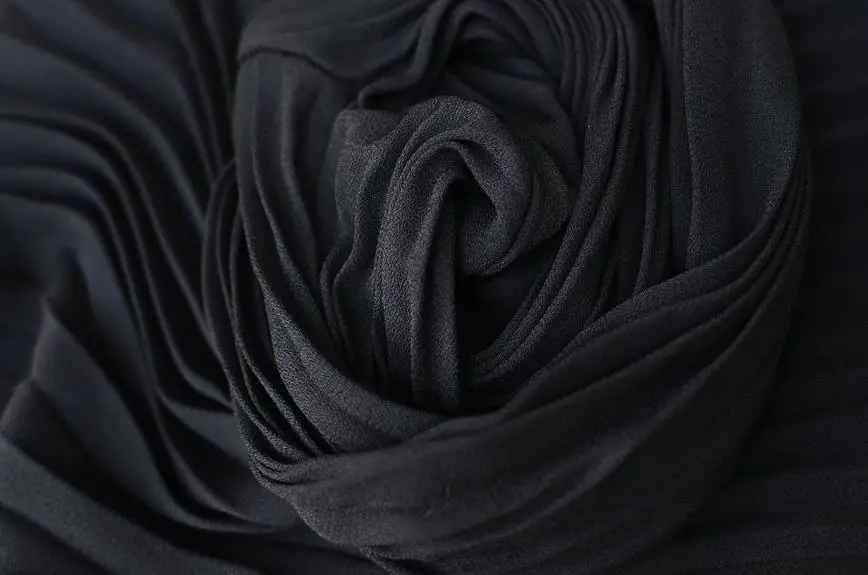Did you know that black Kevlar is considered one of the toughest fabrics in the world? With its remarkable strength and durability, Kevlar has become a staple material in various industries, from aerospace and military applications to everyday consumer products.
In this comprehensive guide, you will explore the origins, composition, and practical uses of black Kevlar, as well as its unique properties that make it stand out as a formidable fabric.
Whether you're a professional seeking to enhance your knowledge of advanced materials or simply curious about the science behind high-performance textiles, this exploration of black Kevlar will provide you with valuable insights into its exceptional toughness and versatility.
Key Takeaways
- Kevlar is composed of long molecular chains arranged parallel to one another, providing exceptional tensile strength.
- Kevlar has high resistance to chemicals and abrasion, making it durable in demanding applications.
- Black Kevlar is widely used in military, aerospace, and industrial sectors for its toughness and protection against sharp objects and ballistic threats.
- While black Kevlar outperforms traditional fabrics like nylon and polyester, extended use in high-stress applications and exposure to humidity and UV radiation can weaken its protective properties.
The Origins of Kevlar
The inception of Kevlar revolutionized the fabric industry with its unparalleled strength and versatility.
Kevlar, a synthetic fiber developed by Stephanie Kwolek at DuPont in 1965, has since found diverse applications beyond its initial intended use in tire reinforcement.
The production of Kevlar involves a complex process of polymerization and spinning, resulting in a lightweight yet incredibly strong material. Its exceptional tensile strength-to-weight ratio makes it five times stronger than steel.
In the fashion industry, Kevlar has been utilized in creating protective clothing for workers in hazardous environments, as well as in high-performance sportswear and accessories. Its use in fashion hasn't only provided safety and protection but has also elevated the level of innovation and functionality in the industry.
The incorporation of Kevlar in fashion has opened up new possibilities for designers, allowing them to create garments that aren't only stylish but also durable and resistant to wear and tear.
The impact of Kevlar in revolutionizing the production of fabrics and its applications in the fashion industry continues to inspire advancements in material science and design.
Structure and Composition
Kevlar's molecular structure and its resilience to wear are key factors that contribute to its toughness as a fabric. Understanding the composition of Kevlar is essential in appreciating its remarkable strength and durability.
Let's take a closer look at how the structure and composition of Kevlar make it one of the toughest fabrics available.
Kevlar's Molecular Structure
Exploring the molecular structure and composition of Kevlar can provide valuable insights into its remarkable strength and durability. Kevlar consists of long molecular chains arranged parallel to one another. These chains are linked together by strong molecular bonding, resulting in a highly organized structure.
The chemical properties of Kevlar contribute to its exceptional performance, as it's composed of aromatic polyamides, which are known for their high tensile strength and rigidity. The unique arrangement of benzene rings in the molecular structure of Kevlar enhances its resistance to external forces. Additionally, hydrogen bonds between the molecular chains further reinforce the material, making it exceptionally tough.
Understanding these aspects of Kevlar's molecular structure sheds light on why it's widely regarded as one of the toughest and most durable fabrics available.
Resilience to Wear
When assessing the resilience of Kevlar to wear, you'll find its molecular structure and composition to be crucial factors influencing its durability and strength. Kevlar's exceptional resistance to abrasion and wear is attributed to its unique properties, making it stand out in terms of performance and durability.
Here's how its structure and composition contribute to its resilience:
- High Tensile Strength: Kevlar's molecular arrangement provides exceptional tensile strength, allowing it to withstand wear and tear.
- Chemical Stability: The composition of Kevlar grants it high resistance to chemicals, enhancing its durability in various environments.
- Intermolecular Bonding: The strong intermolecular bonds in Kevlar contribute to its resistance to abrasion, ensuring long-lasting performance.
- Fiber Orientation: The alignment of the Kevlar fibers further enhances its resistance to wear, making it a top choice for demanding applications.
Industrial and Military Applications
Black Kevlar's exceptional strength makes it an ideal material for a wide range of industrial and military applications.
The military, in particular, requires durable fabrics to protect personnel and equipment in harsh environments, making Black Kevlar a valuable asset.
The fabric's ability to withstand extreme conditions and provide reliable protection has solidified its place in various industrial and military settings.
Black Kevlar's Strength in Applications
When considering industrial and military applications, black Kevlar proves its strength and durability in a variety of high-stress environments. Its exceptional chemical properties and robust nature make it an ideal choice for numerous applications:
- Body Armor: Black Kevlar's high tensile strength and heat resistance make it perfect for manufacturing body armor, providing reliable protection to military personnel and law enforcement officers.
- Aerospace Industry: Its lightweight yet sturdy composition makes black Kevlar an essential material for aerospace applications, including aircraft components and protective gear for astronauts.
- Industrial Safety Equipment: Black Kevlar is utilized in manufacturing safety gloves, helmets, and other protective gear due to its exceptional resistance to cuts, abrasions, and heat.
- Automotive Sector: Its use in manufacturing racing suits, brake pads, and tires demonstrates its ability to withstand extreme temperatures and high impact.
Military's Need for Durability
With its proven strength and durability in industrial and military applications, black Kevlar meets the military's need for durability in demanding environments. Military operations often subject fabrics to extreme conditions, requiring materials that can withstand rigorous wear and tear. Black Kevlar excels in this aspect, providing exceptional resistance to cuts, abrasions, and punctures, making it an ideal choice for military personnel's protective gear and equipment.
Durability testing has consistently shown that black Kevlar outperforms many traditional fabrics, ensuring reliability and safety for military personnel. Furthermore, ongoing fabric innovation continues to enhance Kevlar's durability, making it an indispensable material for the military's demanding requirements.
In demanding military applications, the durability of black Kevlar stands as a testament to its ability to meet the most strenuous needs of the armed forces.
Strength and Durability Testing
You should conduct rigorous strength and durability testing on various fabrics to accurately assess their toughness and performance. When evaluating the strength and durability of fabrics, consider the following aspects:
- Tensile Strength Testing: This measures the maximum load a fabric can withstand before breaking. It provides insight into the fabric's ability to withstand stretching and pulling forces, which is crucial for assessing its suitability for various applications.
- Abrasion Resistance Testing: Abrasion resistance is a key factor in determining how well a fabric will hold up against wear and tear. Testing for abrasion resistance involves subjecting the fabric to repeated rubbing or scraping to simulate the effects of everyday use.
- Tear Strength Testing: This test assesses a fabric's resistance to tearing. It's important for fabrics to have good tear strength, especially in applications where they may be subjected to sharp or abrasive objects.
- Puncture Resistance Testing: Evaluating a fabric's ability to withstand puncture forces is vital, particularly in applications where protection against punctures is essential, such as in protective clothing and equipment.
Conducting comprehensive tests across these areas will provide a thorough understanding of a fabric's strength and durability, allowing for informed decisions regarding its suitability for specific use cases.
Comparing Kevlar to Other Fabrics
How does black Kevlar compare to other fabrics in terms of strength and durability?
When comparing materials for protection, Kevlar stands out for its exceptional strength and durability. In terms of tensile strength, Kevlar is about five times stronger than steel on an equal weight basis, making it an incredibly tough material. This characteristic sets Kevlar apart from other fabrics commonly used for protective gear, such as nylon and polyester.
Kevlar's resistance to cuts, tears, and abrasions further enhances its durability, making it an ideal choice for applications requiring high levels of protection.
When conducting a protection comparison, Kevlar consistently demonstrates remarkable performance compared to other fabrics. Its ability to withstand high impact and resist penetration makes it a top choice for bulletproof vests, motorcycle gear, and industrial gloves. In contrast, traditional fabrics like cotton or wool don't offer the same level of protection against sharp objects or ballistic threats.
Therefore, when seeking the toughest fabric for protective purposes, the comparison of Kevlar to other materials clearly demonstrates its superiority in strength and durability.
Limitations and Considerations
Considerations for using black Kevlar as a protective fabric include its limitations in certain environmental conditions and potential degradation over time. When assessing the suitability of Kevlar for specific applications, it's important to account for factors such as exposure to extreme temperatures and chemicals, as well as the impact of prolonged use on its protective properties.
- Limitations: Black Kevlar may not perform optimally in environments with high humidity or prolonged exposure to UV radiation, as these conditions can weaken the fabric over time.
- Longevity and Durability: While Kevlar is known for its strength, it's essential to recognize that its protective properties may diminish with extended use, especially in high-stress applications.
- Maintenance: Regular inspection and proper maintenance are crucial to ensuring the ongoing effectiveness of Kevlar as a protective fabric. This includes checking for signs of wear, tear, or chemical damage, and following manufacturer guidelines for care.
- Environmental Considerations: Assessing the specific environmental conditions and potential hazards that Kevlar will be exposed to is imperative for determining its suitability and maximizing its lifespan.
Understanding these limitations and considerations will aid in making informed decisions regarding the use of black Kevlar as a protective fabric.
Innovations and Future Developments
An exciting area of advancement in black Kevlar technology involves the integration of nanomaterials for enhanced performance. The incorporation of nanomaterials, such as carbon nanotubes and graphene, holds great promise for further strengthening and toughening black Kevlar fabrics. These nanomaterials can significantly improve the mechanical properties of Kevlar, making it even more resistant to cuts, punctures, and abrasion.
Future applications of black Kevlar are also being explored, with a focus on expanding its use beyond traditional protective gear. Innovations in textile technologies are paving the way for the development of lightweight, flexible, and breathable Kevlar fabrics suitable for a wide range of applications, including sports equipment, automotive components, and even fashion. These advancements may lead to the widespread adoption of black Kevlar in various industries, offering superior protection without compromising comfort and mobility.
As research and development in the field of black Kevlar continue to progress, it's anticipated that these innovations will further enhance the performance and versatility of this remarkable material, opening up new possibilities for its use in diverse fields.
Practical Uses in Everyday Life
You can find practical uses for black Kevlar in everyday life, ranging from protective gear to lightweight sports equipment. Its exceptional strength and heat resistance make it a versatile material for various applications.
Here are some everyday uses and practical applications of black Kevlar:
- Body Armor: Kevlar is commonly used in the production of bulletproof vests and helmets, providing reliable protection for military personnel, law enforcement officers, and security personnel.
- Industrial Gloves: Its cut and abrasion resistance make Kevlar an ideal material for industrial gloves, offering enhanced hand protection for workers in manufacturing and construction industries.
- Sporting Goods: From bicycle tires to racing sails, Kevlar's lightweight and durable properties make it a popular choice in the production of sports equipment, ensuring high performance and longevity.
- Consumer Electronics: Kevlar is used in smartphone cases and other electronic device covers to provide impact resistance and protect against everyday wear and tear.
These examples illustrate the diverse and practical applications of black Kevlar in everyday life, showcasing its remarkable strength and durability across various industries and consumer products.
Frequently Asked Questions
Can Black Kevlar Be Dyed or Colored to Other Shades?
Yes, black Kevlar can be dyed or colored to other shades. The dyeing process allows for color customization, giving you the option to change the color of the fabric to suit your preference.
What Is the Environmental Impact of Producing Black Kevlar?
The environmental impact of producing black Kevlar is significant. The production process involves harsh chemicals, high energy consumption, and water usage. These factors contribute to pollution and resource depletion, making it environmentally concerning.
How Does Black Kevlar Perform in Extreme Temperatures and Weather Conditions?
In extreme temperatures and weather conditions, black Kevlar performs with exceptional durability and flexibility. Its breathability allows for comfort while maintaining toughness. These qualities contribute to its outstanding performance in challenging environments.
Are There Any Health or Safety Concerns Associated With Using Black Kevlar?
When using Black Kevlar, it's important to be aware of potential health concerns. Always follow safety precautions, such as wearing protective gear and handling the material in well-ventilated areas, to minimize any risks.
Can Black Kevlar Be Easily Recycled or Disposed Of?
Recycling options for black Kevlar are limited due to its complex structure, but some companies offer specialized recycling services. Disposal methods vary by location, so contact local waste management for specific guidelines.
- How Does Ring Spun Cotton Affect Garment Fit and Shape Retention? - August 13, 2024
- What Are the Challenges in Producing Ring Spun Cotton? - August 13, 2024
- Is Ring Spun Cotton Suitable for Plus-Size Clothing? - August 13, 2024







